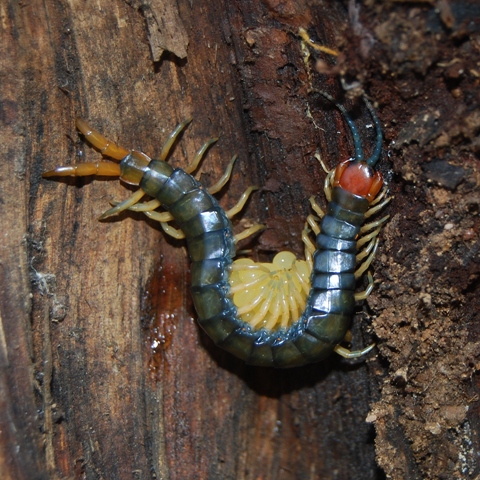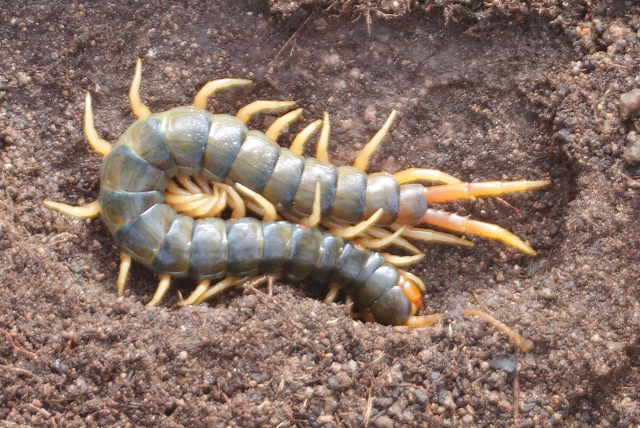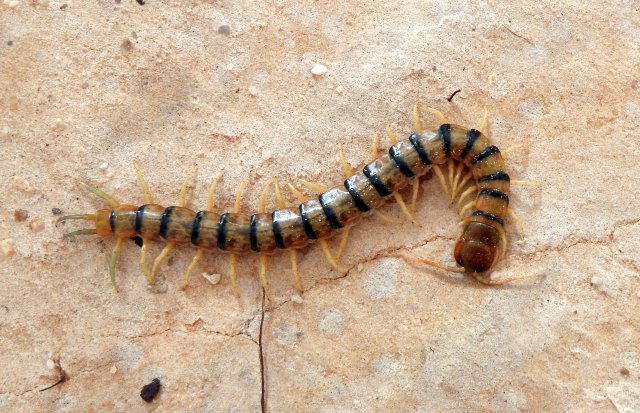Phylum Arthropoda
Subphylum Myriapoda
Class Chilopoda
Order Scolopendromorpha
Common names: scolopendromophs, scolopendrids
Overview
The Scolopendromorpha include the largest and most fiercely predatory centipedes. Because of the toxicity of their venom, scolopendromorphs are the most important centipedes in medical and toxicological research and are the focus of most studies on bites to humans. Scolopendromorphs are strong, flexible animals that range from 10�300 mm and have 25 or 27 body segments and 21 or 23 pairs of legs. The large head capsule is rounded, with filiform antennae consisting of 17 to 35 segments. Many species are blind or have four ocelli on each side of the head. The first pair of legs are modified into powerful poison claws and the tergites of the poison claws and the first pair of walking legs are fused into a single plate. Scolopendromorphs exhibit tergite heteronomy, with segments 2, 4, 6, 9, 11, 13, 15, 17 and 19 being shorter than the others. The pleurites of the terminal segment are fused with the inflated coxae of the last legs to form coxopleurae that extend into a process that is armed with spines and spurs and are usually covered in gland pores. The last legs are larger than the preceding pairs and appear to function in part as prehensile appendages to hold or pinch prey. Scolopendromorphs range in colour through yellow, orange, red, blue and green, with many species also exhibiting darker markings. The Scolopendromorpha comprises the world�s largest centipedes including: Scolopendra gigantea from South America at 30 cm long, and the Australian endemic, Ethmostigmus rubripes, which grows to over 16 cm.
Distribution and diversity
The Scolopendromorpha presently contains three families, Scolopendridae, Scolopocryptopidae, and Cryptopidae. There are 33 genera and around 600 species known, with an estimated global fauna of around 800 species. There are currently 45 described species from Australia.
Life cycle
Pairs initiate mating by tapping each other on the head with their antennae after which the male spins a silken web on which he deposits a spermatophore. The female picks up the spermatophore with her genitalia. Some males deposit the spermatophore directly onto the female genitalia, whilst some deposit it onto the ground and the female picks it up with her mouth and inserts it herself. The female excavates a depression in the soil about 7-10 cm in depth usually under a rock and the eggs are deposited in an oval-shaped cluster and are held together by a gelatinous secretion. Clutch size in scolopendromorphs can vary in size from 9-66 eggs. Females of the genus Cormocephalus touch the egg cluster with their mouths, which covers the eggs with a fungicidal material. In some cases the female will coil her body around the developing eggs and make contact with them with the ventral surface of her body. The female remains in the cavity coiled around the eggs until they have hatched and some species guard the first two stages after hatching. Scolopendromorphs have epimorphic development, the newborn centipedes resemble miniature adults, with a complete complement of legs and body segments although the reproductive parts are not developed. Growth and development is through a series of more than 10 moults. Some species of Scolopendromorpha are matriphagic, meaning that the offspring eat their mother.
Feeding
Scolopendrid centipedes are predatory arthropods and actively hunt their prey. However, when prey densities are high they can adopt a strategy that more closely resembles the sit-and-wait behaviour of other arthropods. The highly mobile antennae explore the area in front of the centipede in search of signs of prey. Prey items include most arthropods, however large specimens have been reported to hunt vertebrates such reptiles, amphibians, small mammals, bats and birds. Scolopendra gigantea, also known as the Amazonian giant centipede, is known to eat bats, catching them in midflight, as well as rodents and spiders. The centipede wraps itself around the prey, securing it with the enlarged hind legs, and biting with the poison claws. The venom is toxic to both mammals and insects, but does not appear to be strong enough to kill large animals quickly. Once paralyzed or killed, the prey is cut into smaller pieces with the mandibles and poison claws, which are then fed into the mouth. As well as being voracious predators, scolopendrid centipedes are also opportunistic and will take carrion when the opportunity is presented.
Ecology
Scolopendromorpha centipedes are distributed through the tropical, subtropical and temperate parts of all continents. They are found in soil, leaf litter, under rocks or bark in dry grassland and forest habitats as well as desert regions. They are nocturnal predators and their predatory function in ecosystems is thought to be significant, however is poorly studied. Scolopendromorphs occupy a number of ecological niches and differ in basic anatomical and behavioural traits. Many species associated with desert regions possess characteristics that enhance their survival in arid and semiarid conditions, such as a reduction in the number and size of coxal pores to reduce evaporative water loss from the body and a more rapid rate of growth and shorter lifespan. Arrhabdotus octosulcatus, a slow-moving, arboreal species in the rain forests of Borneo with very short legs, whose tergites possess seven strong longitudinal ridges that impart exceptional rigidity to the body, resembles a millipede. Scolopendra subspinipes, native to southeast Asia but introduced into many areas of the world, can swim, a beneficial usage of undulations that is advantageous for rainforest species that are likely to be immersed during monsoonal floods.

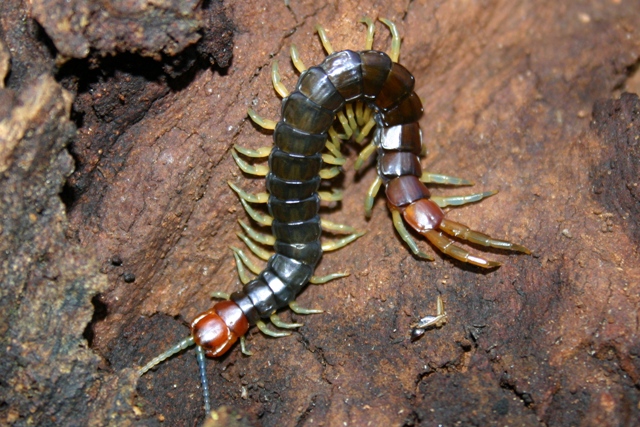
Cormocephalus michaelseni
Image credit: Photographer: Mark Harvey
� Western Australian Museum
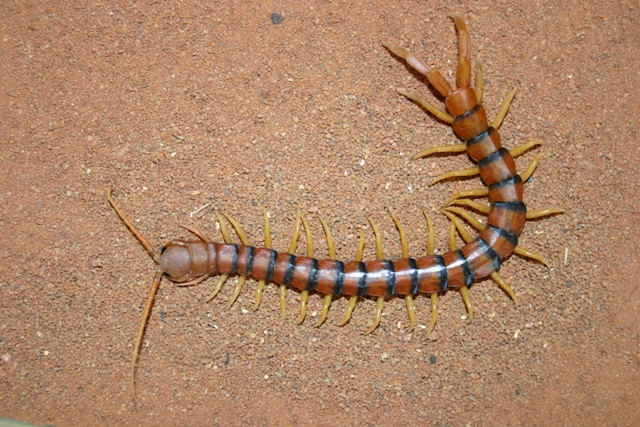
Scolopendra morsitans
Image credit: Photographer: Mark Harvey
� Western Australian Museum

